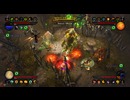
Best Multiplayer

Second Place

Third Place

|
When it comes to multiplayer, few games offer an experience as good as Diablo III: Reaper of Souls did this past year. Initiating multiplayer in Reaper of Souls is incredibly easy, only taking a few clicks to choose the desired game mode, difficulty, and task. Where game finding in Diablo II involved digging through comments in a rapidly refreshing list, Reaper of Souls completes the task of assigning, or creating, a game in a matter of seconds. The variety of goals available, especially in Adventure Mode, make Reaper of Souls's multiplayer shine even more. With bounties, rifts, and more available, there are plenty of ways to start multiplayer games.
In addition to the variety of game settings available, the character class designs themselves are a great boon to Reaper of Souls's multiplayer. While jobs are certainly geared toward specific play styles, every class is able to hold its own, allowing any player to provide competetive damage as well as party-wide beneficial effects. Add to this the extra experience, item, and gold drop bonuses from having multiple players in a game and it almost doesn't make sense to play solo at all. A further testiment to Reaper of Souls's multiplayer superiority over other online RPGs (and its predecessor, for that matter) is the player specific loot drops. Where other multiplayer games often put players in a position where someone is sure to feel they are getting the short end of the loot stick, the individual drops in Reaper of Souls ensure that even if luck isn't always on a player's side when it comes to drops, they won't be fighting over a highly coveted piece of gear when it does finally show up.
While actual multiplayer is a great part of the Reaper of Souls experience, another aspect of player interaction comes in the form of legendary gifts and the Nemesis system. Even if players choose to spend most of their time solo, both of these systems provide subtle, and sometimes deadly, benefits. The gift system allows players to send their friends legendary gift packages that drop randomly alongside normal legendary drops. More significantly, the Nemesis system produces a super-powered demon that jumps between friends' games, growing progressively stronger, until it is defeated. Online multiplayer may not be for everyone, but Reaper of Souls offers an easy and rewarding system that even multiplayer skeptics should give a try.
The role of multiplayer in Souls games has shifted and become more focused since Demon's Souls first introduced us to the invading phantoms, wispy illusions, and inevitable bloodsplatters of others. By the time of Dark Souls II two iterations later, the multiplayer has become more structured, refined, and complex. Bloodstains and ghosts are less helpful in this game's open levels, however interacting with others in more personal ways has been vastly improved upon.
Covenants make it easy to find real help in any situation by encouraging players to provide assistance in different ways. PvP covenants have specific zones for their fights, drawing many PvP gamers away from invading PvE games while giving them a more exciting challenge. When you get invaded, a covenant allows you to automatically summon a helpful shade, quickly turning the fight in your favor. Although shade assistance and phantom invasions are still bookended by lengthy load screens, queue times are noticeably shorter and matchmaking in general leaves soulsigns of various types in key areas at all times. The Souls series has evolved from one where online connectivity is too passive or too intrusive to one where it's a highlight and a fun diversion when the game gets tough.
The Borderlands series was made for multiplayer. As a loot-driven first person shooter with skill trees, multiple character classes, hordes of respawning enemies, resuscitation, and split screen co-op, it packs in every multiplayer mechanic since before even LAN parties were a thing. Borderlands: The Pre-Sequel ups the ante with more bosses and zones that reward cooperation, and new classes and skills that shine when there are other people around to benefit from them. Athena's aggro-pulling defenses, Wilhelm's drone assistants, and Nisha's ability to rapidly thin out an overbearing crowd all seem planned with multiplayer in mind. Claptrap probably does something neat in multiplayer too, but we didn't ask him. While the campaign has its flaws, one being that there isn't enough of it, the attention to multiplayer was well-received at RPGamer.



by Ken Staples, Glenn Wilson
|









